
(Photos courtesy Alta Planning and Design)
A Portland planner’s concept for a way to almost completely eliminate bike-car conflicts from American intersections got its first road test in Minneapolis this month.
“Bikeways for Everyone,” a Blue Cross Blue Shield-funded, Minneapolis-based advocacy coalition with a goal to build 30 miles of protected bike lanes by 2020, invited Nick Falbo of Alta Planning and Design to create a one-day demo at Open Streets MPLS, the city’s version of Sunday Parkways.
It was a follow-up to the group’s pop-up protected bike lane, installed during last year’s Open Streets MPLS (and again this year) to introduce the concept of physically separated bike lanes to more ordinary riders.
This year, they invited Falbo to expand on a concept he started developing last fall and further honed over the winter: a riff on Dutch intersection design imagined in the context of large American streets with protected bike lanes.
As we shared on BikePortland in February, here are the four ingredients of Falbo’s design, which was first imagined for the corner of Southeast 122nd and Division:
Here’s how it might work for someone riding through one on a bicycle (follow the blue arrow):

By adding the eyelet-shaped curbs to the intersection, Falbo’s design shortens the crossing distance for bike traffic and puts right-turning drivers in a position where they can easily see a bike that’s crossing.
Here are some more shots of it in action in Minneapolis on June 8:
Advertisement
“I was really impressed with how children seemed to get it intuitively,” Falbo writes in an email. “They’d roll up through the intersection and just turn slightly to the left and sit in the protected area before crossing. I couldn’t imagine the same thing happening with more conventional designs.”
Falbo, who lives near 82nd Avenue in Southeast Portland, said he’d first hoped that the first demo could be in Portland.
I scanned the Portland Sunday Parkways maps for potential locations where it might be appropriate but unfortunately the routes are almost always on our neighborhood greenways. These streets are too small and not appropriate for the protected intersection design.
Lyndale Ave in Minneapolis was perfect. It was closed to cars as part the annual Minneapolis Open Streets events, and I jumped at the opportunity build a temporary installation. The street normally has 4 lanes and parking. By reallocating two of the travel lanes, we had plenty of room to create a 10 ft cycle track on each side of street, maintain on-street parking, and have room to maneuver around the corner refuge islands.
One important thing to understand about Falbo’s design (which was featured in Wired this morning!) is that it’s mostly theoretical. Falbo’s design presumes two major two-way streets that meet at right angles and both have one-direction bike lanes on each side.
As Portland Bicycle Planning Coordinator Roger Geller noted in an interview two weeks ago, that sort of intersection is pretty rare — and there aren’t yet any such corners in the United States where two protected bike lanes meet.
But that doesn’t mean the design isn’t useful. Two weeks ago, a Portland State University study found that although 96 percent of people who bike in protected bike lanes say they improve safety, between 15 and 37 percent of people feel unsafe at intersections where they have to merge with turning cars.
At an intersection that doesn’t force bikes and cars to merge, meanwhile, only 2 percent of people said they felt unsafe. In the long run, Falbo’s concept could be a great way to bring that sense of safety and comfort to more American streets.



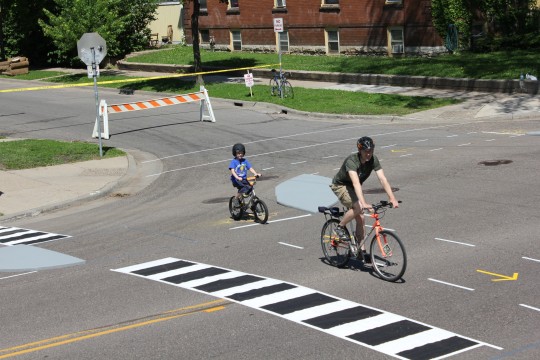
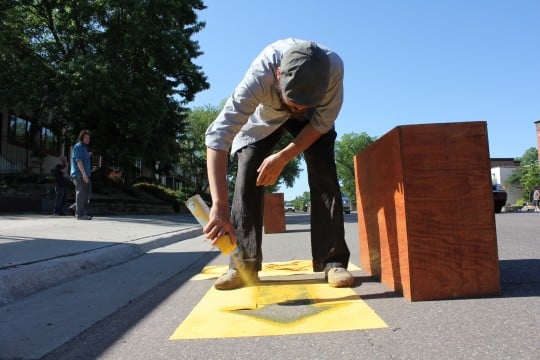
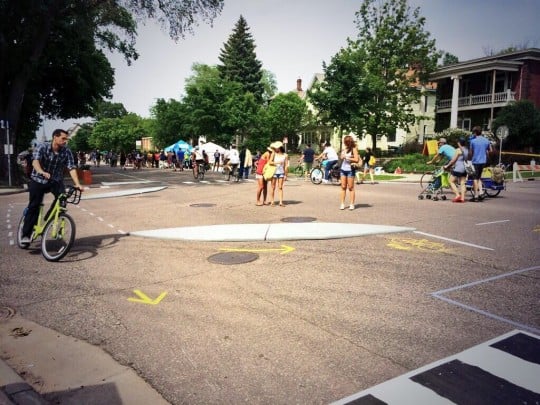

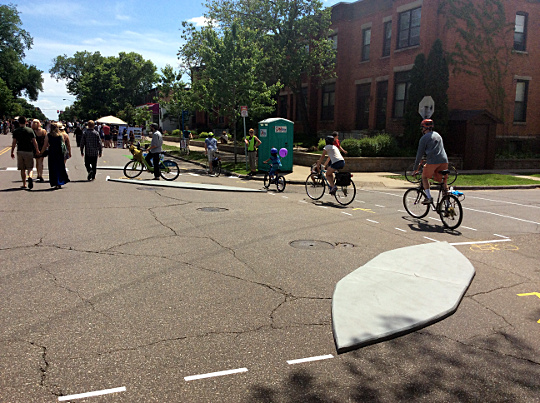
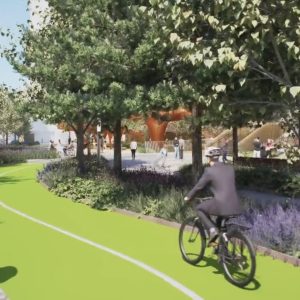
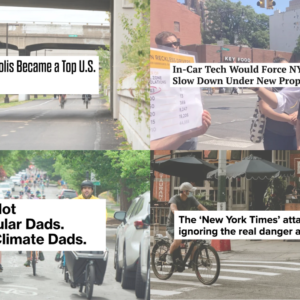
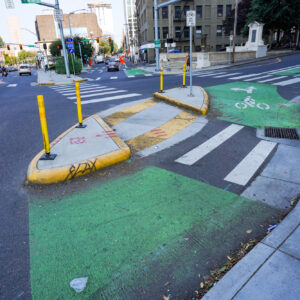

Thanks for reading.
BikePortland has served this community with independent community journalism since 2005. We rely on subscriptions from readers like you to survive. Your financial support is vital in keeping this valuable resource alive and well.
Please subscribe today to strengthen and expand our work.
May be better for cyclists, but not ideal for pedestrians. Too many crossing conflicts; undesirable pedestrian ‘island’ isolation between bike lane and travel lanes. Better solutions exist.
I have to disagree here. The pedestrian(s) would be waiting to cross in a curb extension and therefore more visible to oncoming traffic. Also the design would inherently slow bike riders as they approach the intersection, decreasing serious collision risk for everyone. In cities like Copenhagen and Amsterdam pedestrians routinely have to cross cycle tracks to get to bus stops and crosswalks and there seems to be little to no conflict.
Why build in conflict? This may be acceptable for a low volume residential area but is not for a busy downtown
These are all over central Amsterdam on large streets with tons of pedestrians. I used to ride though these intersections often:
Ex.1 http://bit.ly/1iMG6zL
Ex. 2 http://bit.ly/1pNOFBZ
Ex. 3 http://bit.ly/1poJk2j
What? Bicycle lanes crossing streetcar tracks? And not even close to a 90-degree angle! How does anyone survive riding a bike there??
Because you are building in a low-risk, low-speed conflict to remove a big-risk, high-speed conflict. The area where pedestrians have to worry about being killed by cars is smaller, so it is a net benefit. It works really well in Europe.
These islands are used today in NYC on their protected bike lanes, and they definitely make it easier for pedestrians to cross the street. (Compare that to the free-for-all that is the SW Broadway cycle track).
It’s hard to get a sense of the scale, but these islands are 10 ft deep and as long as you want them to be. They can become mini plaza’s, big enough for trees, seating, lights.
My video focuses on the benefits of this design for bicyclists, but I think they have tremendous unrecognized benefits for pedestrians.
What better solutions do you have in mind, Don? We’d love to report on them, of course.
See the graphic…http://www.ca-city.com/complete_streets/fundamentals.html
So, all lanes protected and bike boxes at all big intersections, basically? I can see that and would love to get Nick’s take.
Yes. A couple of issues that concern me regarding the concept: ADA issues (bike lane in a sidewalk/curb extension) and truck right turning radii. (illustration shows a very tight corner radius– that I like, but may not meet turning standards)
How wide is that right of way, and where would it fit in Portland, Oregon.
Don’s example is an approach deployed today in America and is featured in the NACTO guide. You can see something like this in Portland on the Cully Blvd cycle track, minus the bike box.
Don may be right that in slow-speed, pedestrian-heavy urban environments the “bend in” approach is preferred. However, the right-hook risk remains in this configuration, and some bicyclists may dislike the significant deflection in advance of the intersection. (A complaint I’ve heard about Cully).
In locations with higher-speed traffic and fewer pedestrians (think East Portland, or anywhere outside of a dense downtown), I think the “bend out” approach and corner refuge island may offer a higher level of comfort for both bicyclists and pedestrians.
Isn’t this intersection design just a variation on the “mixing zone” concept as used along Multnomah in its “protected” section? As much as I would rather cruise through intersections with auto traffic either in the lane or in an adjacent (read: “visible”) bike lane, if I were to be forced into one or the other of these designs as a cyclist, I’d pick the “Falbo”. However, as the driver of a long vehicle, I might have concerns about the ability to perform a “button-hook” maneuver at such a protected intersection. Would this force more of the less-desirable “jug-handle” turns at these intersections, or since cycle traffic is shuffled off out of the way, would “jug-handle” turns no longer pose a danger (except to impatient motorists)?
“…there aren’t yet any such corners in the United States where two protected bike lanes meet.”
Ouch. We have a long way to go.
In correct, Vancouver has two.
Vancouver BC is in the United States now?
C’mon, everyone knows we’re the 13th province.
Also, I could be wrong but the protected lanes in question are bidirectional one one side of one-way streets.
That’s right. In fact there are two intersections that way. Hornby street intersects both Dunsmuir street and Helmcken street. All three streets have a two-way protected cycle lane on them. In my experience the intersections are often awkward to use and occasionally scary when there are many pedestrians around and when motor vehicles (illegally turn right) while you’re waiting to turn in a painted bike box.
It’s something that they need to work on.
I don’t know if they have a solution for this in the Netherlands as I don’t think they even use two-way cycle lanes on streets from what I can tell. They must have tried it in the past though as they’ve tried most things.
(And Vancouver is not in the U.S. Different country entirely.)
Here’s a photo of one of the intersection areas in Vancouver: https://flic.kr/p/hUvKRq
That one is actually fairly confusing to new riders, watched somebody try and ride to the right side and had to turn around in front of cars.
I agree. It is a weak gap in two otherwise excellent pieces of infrastructure. I saw on the plan at an open house the City held that there would be a concrete island just before this green square but it looks like it never got built. This means that cars can make a right turn between the curb and someone on a bike waiting for the light to change. It’s happened to me several times and is scary. It means that for some people they don’t have a network there if they don’t feel safe at this point.
Something for them to figure out and work on.
Portland is right next to Vancouver, WA – the ‘other’ Vancouver.
progress is awesome.
Great work Nick!
This would be interesting to try out on a future Sunday Parkways on NE 28th @ Glisan. Thanks Nick! The easiest way to convince people we need better bike infrastructure is to let them try it out for themselves!
Cool to see this idea in action. Way to go Nick!
This is fantastic, but didn’t we see nearly the same concept in a video from Copenhagenize a year or two ago (which I’m now unable to find)?
https://www.youtube.com/watch?v=FlApbxLz6pA
The biggest difference seems to be that the US version assumes there is on-street parking everywhere.
Thanks RJ.
Yep, also linked in the post above (a “riff on Dutch design”). Another key difference is that this is a way to talk about bike-friendly intersections without describing them as “Dutch.” Makes it sound doable instead of foreign.
Thanks Michael — I had missed that.
The original video by Mark Wagenbuur is great. It was where I had first seen this design pitched as an integrated whole, and it’s featured prominently on the protectedintersection.com website.
In my mind, the parking lane is a key element for making this work for American bicyclists. The parking lane provides the space necessary to setback the crossing from the roadway while minimizing deflection for those traveling through. It also provides the space necessary for bicyclists to wait at the forward stop bar or making a left turn.
I’m not sure the design shown in the Dutch video would work well. No one wants to be dodging concrete islands sitting in the middle of the bike lane, and I don’t see enough space for turning bicyclists to wait without interfering with others. It is a good introduction to the concepts, but I think it needed some refinement to become a concept that American designers and engineers could actually visualize on our streets.
Thanks Nick. I absolutely prefer the inclusion of the parking lane, precisely because it features the curb extensions that so significantly aid in safely making crosswalk users visible to road users before they move into the street.
I wish Nick would quit claiming to live in Lents. He’s not nearly cool enough to live east of 82nd.
Ha! The claim is mine, not Nick’s. I’ll remove the specificity.
So no more left turns for bikes.
Requires the double cross.
If it’s done the Dutch way (which I hope it would!), the lights are coordinated so that once you’ve crossed one way, the lights change and you get a green the other way so you can make a left in one go or with very little waiting time. A few examples: https://www.youtube.com/watch?v=67zoLM7l9os&index=7&list=PL91F7BCF9A0E60ADF
That’s nearly impossible except by good fortune where all the signal cycles are short, or one arrives at the first signal at the tail-end of it’s green cycle, and finishes the first crossing right as the second signal goes green.
The closest one could get to allowing a signalized “no-waiting” two-stage left would be to time the signals to stay green only long enough for the “average” bicyclist to cross the street. That might result in more frequent signal cycles and more stopping for those going straight ahead. Forcing two-stage lefts is usually an efficiency loss traded for a perceived safety gain.
Protected left turn signals are the most inefficient use of intersection space. Roundabouts and intersections like this have better total throughput.
Well, I guess the question is one of individual efficiency vs. aggregate efficiency. In my experience, I usually always have to wait longer for two signals than for one. Protected or “free” lefts are better for me if I’m turning left, but I suppose it harms overall throughput because the straight-through traffic has to wait longer.
But what happens to efficiency for bicyclists when cars still get a protected left, but cyclists are forced to do two-stage lefts? Who gets to perform their turning maneuvers more efficiently? Unless an intersection is converted to a full-on roundabout for everyone, then the above hybrid configuration (left-turn signal for cars, signalized roundabout for bikes) is what will likely result. Seems like the aggregate inefficiency of a protected left cycle would be added to the individual inefficiency (but only for cyclists) of waiting for two signals, resulting in the worst of all possible worlds for those on bikes. Advantage: cars. But cyclists won’t mind, since they stay “safer”.
Well, for me at this point, I don’t mind trading some efficiency to feel safer at intersections, especially large, multi-lane ones. But maybe we should just jump to the next stage of intersection evolution, the Simultaneous Green model. http://www.aviewfromthecyclepath.com/2014/05/the-best-traffic-light-solution-for.html It looks like the ultimate in safety AND efficiency since you can go in any direction on green.
Many don’t mind giving up their convenience for a little more safety–unless they drive cars. Why should you pay the price in time–when using a mode that is already slower–because we don’t dare to put the onus for “safety” on those who cause the danger?
With smart signalization the left turn at these kinds of intersections is rarely a long wait or even a wait at all.
Also, an important point often seems to be forgotten in all this theoretical worry over turning times–right turns in this design are *always* freebies! In a conventional setup you are required to stop first on a red light/stop sign and then proceed right. With the protected intersection while turning right it doesn’t matter if there’s a stop sign/red light for cars–you just speed right on through and go your way.
Even ignoring the danger from right-hooks this alone is a marked improvement from 1 step -> 0 step turns for *half* of the turns you’ll ever make. You’ll find in practice biking on pervasive separated infrastructure this very quickly adds up.
Again, suddenly 50% of your turns suddenly have *no* step involved.
As mentioned before, adding in smart signalization for left turns and the end result is fast turns throughout. In practice this kind of system works very well.
Left turns shouldn’t necessarily require a double cross. Assuming traffic allows, you should still be able to move left prior to the intersection and make a left turn in the same way as motor vehicles, just as at any other intersection.
The difference here is that it’s much easier to do a “Copenhagen left,” aka double cross, if you so choose, and hopefully the adjusted signal timing would penalize you less for doing so.
If you look at the diagram, you’ll see that this design presumes separated cycle tracks – there is no way to “move left” prior to the intersection.
That’s not necessarily true of protected bike lanes. I always manage to move out of the NE Multnomah protected lane to make left turns just fine.
Yay, more urban construction!!!
From the diagram, 6 ft bike lane + 3 ft protection + 8 ft parking lane + 10 ft auto lane + 5 ft for half the turn lane = 32 ft half street x 2 = 64 feet curb to curb, minimum. Portland curb extensions are usually 6 ft wide, 7 at most and the “islands are 10 ft deep”, hence the 3 ft raised buffer (could be 4′ if the curb extension is 6 ft wide); the auto lane should be 11 feet for trucks and buses; the bike lane would be better at 6 feet.
SE 82nd is 56 ft curb to curb. Where in Portland would the diagram work?
This approach should work anywhere you have a parking protected cycle track. SW Broadway could use this today, NE Multnomah is a little tight, but could probably swing it. It probably would have worked on NE Cully.
If the Outer Holgate, or Stark/Oak buffered bike lanes were configured as cycle tracks, there should be enough room.
Any street with parking where you reconfigure a lane of travel to create a parking protected cycle track will probably provide the space you need.
Note multiple people on bikeshare bikes (the lime green ones). Is one of those people Nick himself?
Yes! Believe it or not it was my first time using a bike share system.
and?
I’m convinced it’s going to be great here in Portland. One thing the Minneapolis system has done is spread stations fairly thinly in their outer areas, which goes against the conventional “district” approach of providing a dense network of stations across an area.
This works well in Minneapolis because they have an amazing pathway called the midtown greenway that connects these spread out stations, so you never get to far away from a docking spot. A similar approach may be possible in Portland along the multi-use paths, or some hypothetical future cycle track.
Yes, I found that true. There were stations along the path that leads from downtown almost the whole way to the airport (which also parallels the light rail line). I used that path to get back half of the way to the airport. Just docked my bike and road the train the rest of the way.
IMO, this infrastructure basically assumes that cyclists will not jay bike, bike at very slow speeds, and that pedestrians and cyclists will both pay very close attantion to each other’s right of way. Moreover, it’s the kind of infrastructure that seems intentially designed to slow cyclists down. How are we going to compete with the convenience of motorvehicles if we build infrastructure that intentionally makes cycling annoying?
I am willing to bet that for the same approximate cost bike-specific signals could be implemented. Bike specific signals would allow simple and straight signalized crossing and avoid pedestrian conflicts.
sorry for the typos…
For those not familiar with it, this stretch of Lyndale is 4 lanes (two each way), with no bike lane or center two-way turn lane, much like Division was between 60th and 82nd until a few months ago, or like East Burnside is from 13th to 68th today (and quite a few other Portland streets, of course).
Like those streets, its capacity is underutilized most of the time, and often it invites people (many of whom live further out) to drive too fast through a moderately dense central-city neighborhood that has substantial bike-trip demand and a pretty fair amount of pedestrian traffic around a few busy retail and restaurant locations. Like those streets, it screams for some traffic calming and (possibly protected) bike lanes so it feels less like a commuter boulevard, and more like the vibrant commercial district that it is in places – and would be all the way from 31st to Franklin if it felt safer).
One key difference, which might pose a minor challenge in Minneapolis, is snow removal. Minneapolis does have a bunch of special narrow snowplows that clear their extensive network of off-street paths, and I presume those would have to be used here to clear the bike lanes through these intersections (or, really, any protected bike lanes), since standard snowplows won’t fit. The edges of the “islands” will probably have to be marked with poles so the plows don’t hit them. These problems are soluble, and fortunately we don’t have to worry about them in Portland.
If Minneapolis, with its climate challenges, can explore this there’s no excuse for us not to. Keep nipping at Portland’s heels! Now that it’s been demo’ed on a street that’s closed, the next step is to get a longer-term pilot installation somewhere we can demonstrate how it works WITH traffic flowing. Hopefully with the signal timing adjustments to make it work really well … I’m sure Peter Koonce already has the details worked out.
it’s a 1 day temporary demonstration in june so mpls’ climate is irrelevant.
Yes, obviously Mpls’ climate was irrelevant for a 1-day demo in June. It’s pretty obvious from my post that I was talking about the benefits and challenges of really implementing these things, not just 1 day demo events.
Don’t be too envious about whose idea it was and who tried it first. Lyndale & 25th is a bad intersection not unlike almost any SE residential street that meets up with 39th. This experiment isn’t being done at speed or even in a place where you’d implement the idea.
Source: lived in the neighborhood for years, including a stint one block away from that intersection on Aldrich.
Boy, I just love the stuffing out of the chutzpah that this has taken to get going as a conversation. I have lingering questions about curb-to-curb needs for paratransit, but what is so awesome is that an on-the-ground demonstration allows us to both ask questions and find answers. So badass.
I, too, am wondering where such a street would fit in Portland. Basically you need a roadway that is 7 lanes wide curb to curb. Bike+buffer, park, drive, turn, drive, park, bike+buffer. What streets are those, in our city?
most of them would be in East Portland, right?
East Portland is the most likely area to find two such roads crossing.
SE Holgate at 92nd (do we really need those right turn lanes?), or 122nd?
SE 122nd at Foster, Division?
Out and about yesterday, Rosa Parks looked promising, Maybe at Denver, if Denver wasn’t offset.
The concepts presented so far don’t have traffic volumes attached. The peark hour turn demands might make such concepts difficult to implement in east Portland.
The congestion created to accomodate a protected bike lane would require an elected with great intestinal fortitude and no desire for re-election, just a desire to do the right thing.
John, see my response to Paikiala above. Anywhere you have a parking protected cycle track should provide adequate space. The most compatible locations would probably be outer east Portland arterials, but I think there are many opportunities around inner Portland.
Yep. Just about any arterial street East of 82nd that intersects 122nd looks like Lyndale at the intersection…
I don’t understand how they can afford this. Wouldn’t that cost millions of dollars? I thought this country was a bankrupt 3rd world country by now!
A parking protected cycle track -without the raised curb in the buffer, is not very expensive, $18k/mile, so the islands at the corners would be the more concentrated cost items. Each corner might be revised for $15k-$20k, so about $80 k per major intersection.
Impressive, Nick. You make us proud.
Without any cars or trucks, I’m sure the demo project will work great! : ) More seriously though, these need to handle trucks that may turn in the intersection. And what concerns me is that motorists will not tend to yield at the crosswalk/crossbike. They may yield to peds but what if there are no peds and a fast moving (10-15mph is fast moving in this scenario) cyclist enters the crosswalk/bike as the motorist is turning? Yielding rules and habits will be seriously tested by this design.
“…Yielding rules and habits will be seriously tested by this design.”
Don’t worry. Oregon already has this figured out: cyclists are not to approach a crosswalk at faster than an “ordinary walk”. Here’s how the BikePortland story would go:
“CYCLIST HIT AT CORNER OF * AND *
A person riding a bike was knocked down as she attempted to use the new protected bikeway installed last month. A witness states that the rider was going straight through the intersection at a high rate of speed when the turning car struck and knocked her down. Based on witness statements and a cursory inspection of the scene, the rider was given a citation for “unsafe operation of a bicycle on a sidewalk” before being transported to the hospital with non-life-threatening injuries. The driver stayed at the scene and was apparently cooperative with police; no citation was issued to the driver.
We asked a PBOT spokesperson why no bicycle-specific signal had been installed when the intersection was redesigned, since a separate signal phase for bike traffic and car traffic would eliminate the kind of turning conflict that resulted in this crash, and were told that “[the need for separate signals] was brought up during the planning process, but budget constraints and concerns about traffic delays resulted in the removal of that piece from the overall concept. Instead, we decided to put up a ‘NO RIGHT TURN ON RED’ sign, which we thought would eliminate a lot of the kind of right turns that can cause these unfavorable interactions. We still believe this intersection can work; it will just be a bit of a learning curve until all users get it figured out.”
If the bikes are turning left in the bike lanes w/ their own signal why is the auto left turn pushed back from the intersection?
Btw – i don’t mind making that kind of cross on a big intersection, never felt all that comfortable riding in with traffic for a left turn – its scary.
I assume that’s in part because the turning radius is a bit tighter due to the teardrop refuge islands. Of course all along cars are supposed to have been turning within as tight of radii as possible but when this isn’t reinforced by infrastructure cars tend to turn as widely as the road allows.
YES–love this protected intersection demo!!! I’ve been wondering for awhile about how to demo this kind of intersection treatment.
As a practical matter I’m curious how this kind of demo can be replicated in other places (such as SF where I live).
We really need to get this demoed in lots of places–really exciting work!
For a Dutch person all this dicussion is really funny. We heave these things all over the place and no one thinks twice about them. We get upset if they’re not in place. But every situation needs its own variation on this theme, so yes, you can use it on streets with only bike lanes in one direction, or two, or all four, five or more, no problem. The key point is to think flexible about it.
Good luck, I really like the efforts, who knows, maybe we’ll learn something new from it.